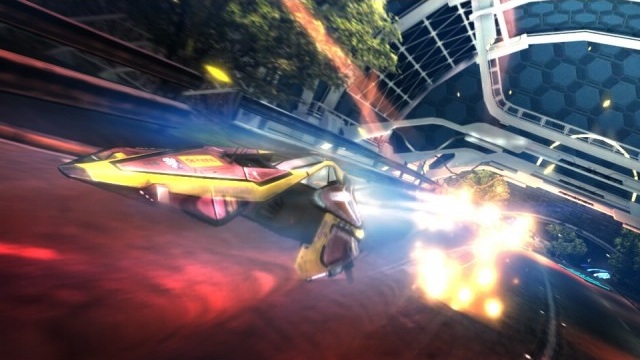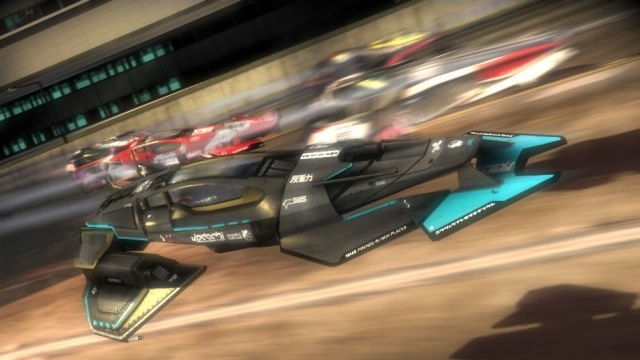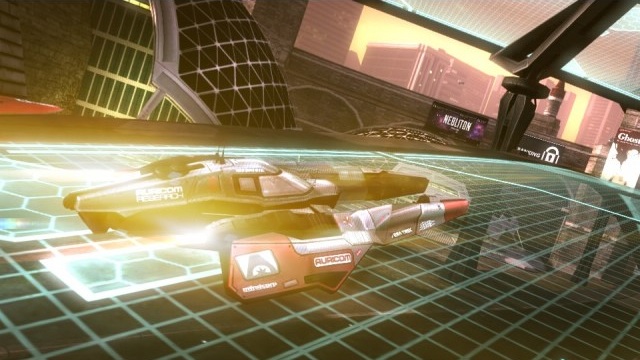New York City drivers got nothing here.
Per series tradition, races in WipEout are ridiculously fast. Don't glance away, consider changing your major, or think about where to get lunch, because your ass will be eating a wall the split second your mind wanders.
As usual, players blaze around a futuristic track and pick up weapons which they must use wisely on their path to the winner's circle. Those new to the series will inevitably compare this to Mario Kart, which, while somewhat valid, are not as accurate as they might initially seem. True, both are racing games that involve shooting opponents with power-ups, but that's about where the similarity begins and ends. For one thing, it's a lot harder to connect with the projectiles in WipEout, and when one does get clocked, it's usually not as damning. Races are much faster and more difficult, thanks in part to the inclusion of twitch skills and mechanics like strafing and barrel rolling.
Weapon pick-up pads in 2048 are divided into defensive and offensive categories; drive over a green defensive pad and you're bound to pick up something like mines or a speed boost, while driving over a yellow offensive pad snags rockets and other projectiles. You will enjoy this added layer of strategy and memory in knowing what type of weapon you need at what times, so making sure to drive over the pad that can give it to you can make a big difference in the outcome of an event.
Previous installments didn't have as many power-up spots, suggesting a greater emphasis on combat in 2048. Outside of the regular races, battle mode focuses on the destruction of opponents rather than the rush toward a checkered flag. Taking place on the same tracks as standard racing, combat stages might draw some WTFs at first, but they're actually well-done and, after you get the hang of them, provide as much fun as the races. Since it's not a race, however, sneaky players might turn around and snipe fools. After a few go-rounds and unlocking some good fighter ships, the combat events become as fun as the main races—some people might even grow to like them more. As you can imagine, these are much more fun online than against the CPU.
Other modes include Phase and Time Trial, the latter of which is self-explanatory. Phase mode automatically mashes the gas, gradually increasing the speed as time goes by. As the minimum speed climbs higher and higher, players must focus and get into the zone in order to survive long enough to clear the stage. Hit too many walls, lose the ship's HP, and BOOM!, stage failed. The first one or two Phase events are somewhat boring, but like most things in the game, the events get more and more intense. Phase mode, however, while good for practice, can't hold a candle to the races and combat. As more events are unlocked, some players are likely to look forward to Phase events less and less. How fitting then, that they appear much less in the campaign mode's final season.
Online play is laid out in campaign format, not allowing players to build the match they want but sending them through a linear course of seemingly random selection. Players in a lobby will vote from one of two presented options, wait for a confirmation countdown, and then begin trying to kill each other. Load times unfortunately run at the opposite pace of the wickedly fast races. It can take up to a minute to load the race or battle in question, naturally longer online.

WipEout 2048 is visually superb. The ships and environments are constantly impressive, and right along with Uncharted: Golden Abyss, this is a game that really shows off Vita's graphical power. It runs at 30 frames per second, but you'd never know it, considering how gorgeous it looks and how smoothly it runs. Even at the lower resolution than the PS3's WipEout HD, it rivals its PS3 predecessor, with a particular nod to the lighting effects and textures.
The art and layout of the tracks add to the graphical beauty. Set in New York City in the year 2048, the tracks are futuristic re-imaginings of Big Apple landmarks as recognizable as the Empire State Building. As players progress through future seasons, recognizable tracks from the series show up, including the track we love to hate: Sol.
The only visual problem the game has is its sight distance, an especially big problem on the Subway track. Pretty as things are, races move extremely fast, so seeing several hundred yards ahead is a necessity, but the lights and scenery can sometimes blend together too much and make it hard to anticipate what's coming, not giving players enough time to react to the track in front of them. On the Subway course, this often results in a head-on collision with a median. The problem gets worse if there are more than one or two ships ahead of the player, as the explosions and smoke will obscure the view even further, making track memorization more of a requirement in this game than it tends to be in other racers.
Courses include countless side paths and forks in the road, usually having a clear "main" path and another, slightly narrower, alternate path. Due to their tighter, more difficult entry, it's no wonder the game calls them "Skillcuts". Taking them successfully, however, can be a key to victory. Being in fifth place and knowing you need to place third in order to unlock the next event in the campaign, then mustering up the courage to go for the Skillcut and barely sneaking into qualification creates quite a rush.

WipEout 2048 would have benefitted greatly, though, from a fully customizable control configuration. As it is, there are three pre-made layouts to choose from, but none of them are a perfect setup. Due to how close together the Vita's face buttons are and how the right stick is in the 'X' button's grill, one control scheme in particular poses big problems for me and my man hands. The control scheme that has 'X' for gas and the analog stick for an 180-degree turn is prone to accidents. Another control scheme eliminates airbrakes entirely and they're necessary for turns. So with any given setup, there is a noticeable disadvantage. Difficulty should come from opponents and gameplay, not the control configuration.
The game is also a bit on the linear side, with not many tracks and events available from the beginning. In order to get more tracks and crafts, players must race through the campaign mode—racing, battling, and clearing Phase courses which become available in a certain order. It's all good fun, yes, but it would have been better to at least have the option to mess around with a few more of the tracks and crafts right from the start. Thankfully, passing an event will oftentimes lead to multiple others opening up, so it's not exactly a straight sequence of events in a prescribed order. For those that just can't seem to best a certain tricky task, the game will eventually allow the event to be skipped; you're not forced to retry without end, which is great.
Clear all of the events in a given year, and you'll move onto the next, more difficult season. Notably, difficulty ramps up in the 2050 season. While the 2048 season can be dominated and the 2049 season doesn't pose too much challenge either, especially for WipEout veterans, the 2050 season will kick a lot of asses. You'll really need to know exactly how and when to use each weapon, master the airbrakes and barrel rolls, and develop a good memory for the tracks to succeed. The thrill of finally running a great race and clearing a 2050 event that's been trashing you for a while feels great and makes for a satisfying play experience.
WipEout is just as visually impressive and, more importantly, every bit as fun as it's ever been in 2048. It's not without a few small problems, but it provides an exciting experience for racing fans, be they series newcomers or longtime WipEout followers. As of Vita's release time and much of the foreseeable future, this 17-year-old franchise will lay claim to the title of the system's overall best racing game.
-
Awesomely fast races
-
Maybe too fast, particularly from B to A class
-
Campaign mode is well-constructed and has a lot of variety
-
Smooth visuals and wonderful track design
-
Unique among other racers
-
Online is slick and easy to jump into
-
Can't set custom online matches
-
Can't customize a control scheme
-
Long load times, especially for a portable







